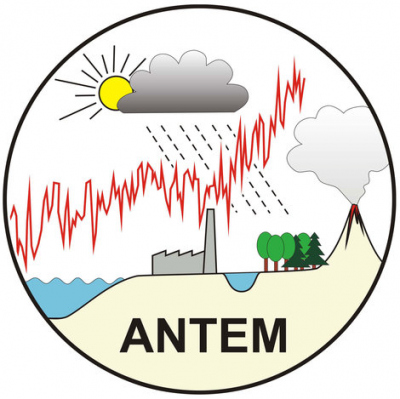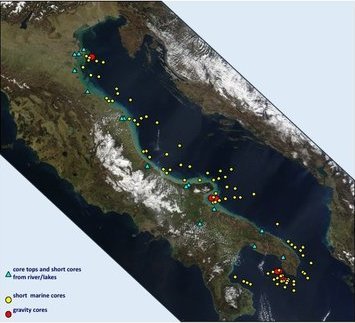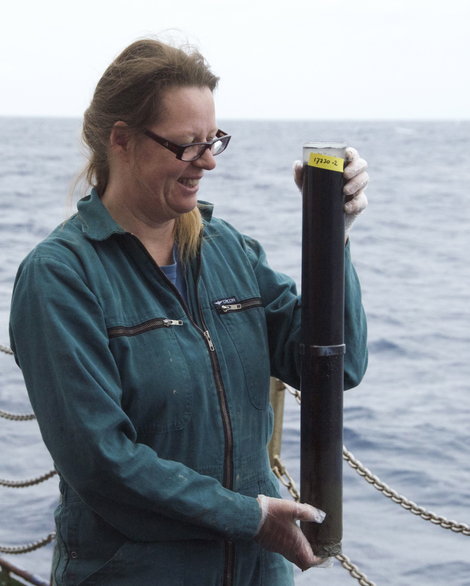Page path:
- AG Kucera
- Research
- Paleoceanography
- ANTEM - Recent Climate Change
ANTEM - Recent Climate Change

The international ANTEM research consortium (Anthropogenic and Natural forcing of The European Mediterranean climate in the last 5 millennia) develops, tests and applies tools to determine the rate of natural and anthropogenic forcing of the marine coastal environment and climate in the Southern Italian region during the last 5000 years.
This is achieved by applying a new iterative workflow that integrates high-resolution marine and lacustrine proxy studies with physical ocean-biogeochemical model experiments to achieve a higher accuracy of both proxy and model outcome. The focus lies on changes in key-parameters of the climate and environment of the system such as temperature, salinity, trophic state of the upper marine waters and bottom-water redox state as well as human activity in the region.
This is achieved by applying a new iterative workflow that integrates high-resolution marine and lacustrine proxy studies with physical ocean-biogeochemical model experiments to achieve a higher accuracy of both proxy and model outcome. The focus lies on changes in key-parameters of the climate and environment of the system such as temperature, salinity, trophic state of the upper marine waters and bottom-water redox state as well as human activity in the region.
The spill of the research activities within the consortium is formed by four studies that further develop, tune and apply (1) a physical ocean-biogeochemical model for the South Italian coastal region that enables modelling of synthetic sediment cores, (2) organic geochemical methods that provide detailed information about high temporal variability in the climatic parameters temperature and the precipitation/evaporation balance, (3) palynological tools to determine human activity and marine environmental change and (4) sedimentary tools to establish detailed tephra based chronologies and reconstruct changes in the marine and terrestrial environments for the last 5 ka.
For all projects marine and lacustrine core material of unique quality is available that allows the generation of the above mentioned information for the last 5 millennia with a temporal resolution of three years for the marine cores and one year for the lacustrine sediments. The core sites are located downwind South Italian volcanoes that allow the establishment of robust and independent chronologies supported by tephrochronology. This ensures the precise correlation of the records and allows the scientific activities to be precisely focussed on time intervals of large environmental and climate change, such as the pre-industrial - industrial transition (last 200 years), the Little Ice Age, the Medieval Climate Anomaly, the Roman Climate Optimum and the Homeric Transition. For the research area the world-wide longest instrumental data series are available of River discharge (daily measurements of the last 200 years) and central Italian air temperature (from 1654 onward)

Our department studies the downcore marine sedimentary pollen/spores and charcoal content to establishing high temporal resolution reconstructions in vegetation and key aspects of anthropogenic impact including agricultural, industrial and fire activity. Changes in the sedimentary dinoflagellate cysts and planctic foraminiferal composition is used to reconstruct past marine environmental conditions including upper water trophic conditions and bottom water redox conditions.

Insight in the natural and anthropogenic character of the variability is gained by comparison with archeological and historical information and with instrumental data available in (online) databases such as the world-wide longest instrumental data series of Po-river discharge and central Italian air temperature. Furthermore we compare the results with information of potential natural steering factors such as solar insolation, volcanic activity and variability in for the region relevant climate modes (e.g. the North Atlantic Oscillation). We test the downcore variability in palynological signals on its cyclic character using frequence and wavelett analyses.
PhD Projects
Liang Chen, 2010 - 2012: Subdecadal paleoceanographic and paleoclimatic reconstructions of Late Holocene oceanographic conditions of the Eastern Mediterranean based on organic walled dinoflagellate cysts
Master Projects
Marijke Taverne-Gieseke, 2013: Zeitlich hochauflösende studie über Veränderungen des küstennahen marinen Ökosystems Süditaliens während der „Roman Warm Period“ (200 BC - 60 AD) anhand von dinoflagellatenzysten.
Caroline Clotten, 2013: Palaeo-environmental reconstructions related to short-term climate changes in the Gulf of taranto (South italy) based on organic-walled dinoflagellate cysts for the post Roman Optimum (AD 200 - 300).
Caroline Clotten, 2013: Palaeo-environmental reconstructions related to short-term climate changes in the Gulf of taranto (South italy) based on organic-walled dinoflagellate cysts for the post Roman Optimum (AD 200 - 300).
Bachelor Projects
Publications
Chen L., Zonneveld K.A.F. and Versteegh G.J.M. (2013). Paleoclimate of the Southern Adriatic Sea region during the Medieval Climate Anomaly reflected by organic walled dinoflagellate cysts. The Holocene 23(5) 645 - 655.
Grauel, A-L., Leider, A., Goudeau, M-L., Müller, I,A., Bernasconi, S.M., Hinrichs, K-U., de Lange, G.J., Zonneveld, K.A.F., Versteegh, G.J.M. (2013) What do SST proxies really tell us? A high-resolution multiproxy UK‘37, TEXH86 and foraminifera δ18O study in the Gulf of Taranto, central Mediterranean Sea. Quaternary Science Reviews 73, 115-131
Zonneveld, K.A.F., Chen, L., El-Shanawany, R., Fischer, H.W., Hoins, M. and Pittaurova, D. (2012) The use of dinoflagellate cysts to separate human-induced from natural variability in the trophic state of the Po River discharge plume over the last two centuries. Marine Pollution Bulletin 64, 114-132.
Chen L., Zonneveld K.A.F. and Versteegh G.J.M. (2011). Short term climate variability during the “Roman Classical Period” in the Eastern Mediterranean. Quaternary Science Reviews 30, 3880-3891.
Zonneveld, K.A.F., Chen, L., Möbius, J. and Mahmoud, M.S. (2009). Environmental significance of dinoflagellate cysts from the proximal part of the Po-river discharge plume (off southern Italy, Eastern Mediterranean). Journal of Sea Research 62, 189-213.
Grauel, A-L., Leider, A., Goudeau, M-L., Müller, I,A., Bernasconi, S.M., Hinrichs, K-U., de Lange, G.J., Zonneveld, K.A.F., Versteegh, G.J.M. (2013) What do SST proxies really tell us? A high-resolution multiproxy UK‘37, TEXH86 and foraminifera δ18O study in the Gulf of Taranto, central Mediterranean Sea. Quaternary Science Reviews 73, 115-131
Zonneveld, K.A.F., Chen, L., El-Shanawany, R., Fischer, H.W., Hoins, M. and Pittaurova, D. (2012) The use of dinoflagellate cysts to separate human-induced from natural variability in the trophic state of the Po River discharge plume over the last two centuries. Marine Pollution Bulletin 64, 114-132.
Chen L., Zonneveld K.A.F. and Versteegh G.J.M. (2011). Short term climate variability during the “Roman Classical Period” in the Eastern Mediterranean. Quaternary Science Reviews 30, 3880-3891.
Zonneveld, K.A.F., Chen, L., Möbius, J. and Mahmoud, M.S. (2009). Environmental significance of dinoflagellate cysts from the proximal part of the Po-river discharge plume (off southern Italy, Eastern Mediterranean). Journal of Sea Research 62, 189-213.


